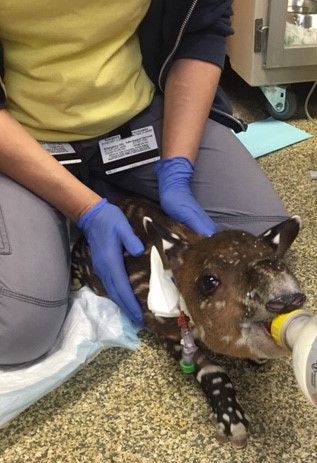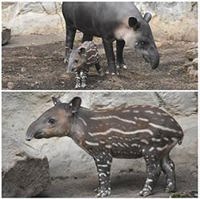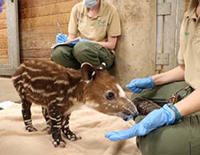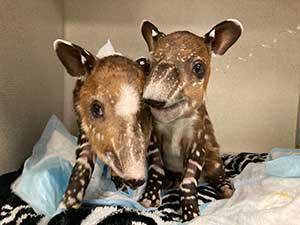Baird’s tapir twins being treated for health complications
Friday October 2, 2020
UPDATES
Our tapir tot, Millie Tanya Tapir, has made her exhibit debut! November 7
We appreciate you keeping our Animal Care team and the extraordinary team at Cummings School of Veterinary Medicine at Tufts University in your thoughts. November 6 Major milestone for our little female – she successfully reunited with mom, Abby, this week! The calf was seen nursing within hours – even gaining weight since the intro – and Abby has been acting like the wonderful seasoned mom that she is. The pair will remain behind the scenes to continue bonding before making an exhibit debut. October 23 Our tiny duo continues to make progress. We’re happy to report that the female calf has been doing well enough that she was able to return from Cummings Veterinary Medical Center to Franklin Park Zoo this week, where she and mom, Abby, have visual access to each other. She has been acclimating well, and staff is monitoring her health and progress very closely, day and night. The goal is to physically reunite Abby and the calf as soon as it’s safe to do so. The male calf is making incremental improvements, and remains in an oxygen enclosure at the Medical Center, where he continues to receive around-the-clock care. Because the twins were born developmentally premature, their bone development has a ways to go before they can be fully active. The female will receive radiographs weekly to monitor her development and determine when she’s ready for increased exercise and a reunion with Abby, before they make an exhibit debut together – likely several weeks away still. October 15 The 2-week-old babies remain at Cummings School of Veterinary Medicine at Tufts University this week, where the around-the-clock care continues. While the female calf continues to do well, the male has unfortunately experienced a setback and requires much more intensive care. Yesterday, he was anesthetized for intubation, placement of a jugular catheter and a CT scan of his lungs, which revealed severe pneumonia. He remains on a ventilator today with a guarded prognosis for recovery. We can’t thank all of you enough for the kind words and good thoughts for these little ones during this difficult time. We’ll continue to update you along the way. October 6 The twins continue to receive around-the-clock care at Cummings Veterinary Medical Center at Tufts University, where they're together in an oxygen enclosure within the ICU. They've been improving each day, are stable and feeding well. The female is off of IV fluids and no longer needs the extra oxygen support. She is still in the oxygen enclosure to be with her brother, who has pneumonia and continues to need this supportive care. The twins have made very good progress, but will continue to need a lot of support as they grow and try to catch up on their development. We'll continue to provide updates on the twins, and appreciate your continued thoughts and well wishes. |
After experiencing health issues yesterday afternoon, the newborn Baird’s tapir twins, born on September 29 at Franklin Park Zoo, were transported to Cummings Veterinary Medical Center at Tufts University for assessment, treatment and care.
The twins, a male and a female, are currently together and stable in an oxygen enclosure in the ICU. Both are receiving fluids, dextrose and antibiotics. They have high sodium levels, which the team is slowly working to bring down. The male has radiographic evidence of pneumonia. The twins showed interest in nursing this morning, which is a good sign although they are still in critical care.

As of yesterday morning, the twins had been doing well and had gained a little weight. Following an exam earlier in the day at Franklin Park Zoo, the twins slept most of the day, which was not unusual. Staff became very concerned though when they were difficult to rouse for feedings, and were poorly responsive, especially the female.
“In preparation of this highly unusual birth, we prepared for many different scenarios and consulted with colleagues at Cummings School of Veterinary Medicine at Tufts University throughout the pregnancy. We were prepared to transport the twins if needed, and quickly made the decision early yesterday evening to do this out of concern for the twins’ health,” said Dr. Eric Baitchman, Zoo New England Vice President of Animal Health and Conservation. “The twins were stable this morning thanks to the absolutely heroic efforts by the Tufts’ team last night. I remain hopeful for their survival and eventual ability to thrive, but we have a very long way to go.”
While twins are an incredibly rare occurrence in all tapir species, this pair is believed to be a first for Baird’s tapirs as the Zoo’s staff can find no record of this occurring previously in zoos or in the wild. While their mother Abby did go full-term with the twins, further exam of their bone development has revealed that the calves are developmentally premature and will require a lot of care as they grow, including potentially splinting their limbs to provide orthopedic support. The twins weigh just under 10 pounds each, which is approximately half the weight of a newborn tapir singleton.
“Our team is vigilantly monitoring and providing supportive and specialty care to the Baird’s tapir twins,” said Dr. Cheryl Blaze, hospital director at Foster Hospital for Small Animals at Cummings Veterinary Medical Center at Tufts University. “While their condition is still critical, we have specialists across small and large animal medicine—with expertise in intensive care, zoological and respiratory veterinary medicine—doing everything they can for the patients.”
While the twins were at Franklin Park Zoo, Abby had visual access to them and the plan has been to reunite them. However due to all of the care the twins will need for continued survival, it is highly unlikely that the Zoo team will be able to reunite them anytime in the near future.
ZNE participates in the Baird’s Tapir Species Survival Plan (SSP), which is a cooperative, inter-zoo program coordinated nationally through the Association of Zoos and Aquariums (AZA). SSPs help to ensure the survival of selected species in zoos and aquariums, most of which are threatened or endangered, and enhance conservation of these species in the wild. Abby has previously given birth to four healthy calves, each of whom resides at other AZA accredited institutions per breeding recommendations by the SSP. The twins are the result of a recommended breeding between Abby and her late mate Milton. When Milton passed away at age 30 last year, he was the oldest Baird’s tapir within the AZA managed population.
An endangered species, Baird’s tapirs are the largest land mammal found in South America. Baird’s tapir calves are noted for their furry coat covered in spots and stripes, which helps to camouflage them in the dappled light of the forest. The spots and stripes fade at about six months as their coat darkens.
Zoo New England is committed to Baird’s tapir conservation and partners with the Baird’s Tapir Survival Alliance to protect Baird’s tapirs in Central America. While these animals are hunted for food and sport, their greatest threat to survival is habitat destruction due to logging and clearing of land for agriculture and development. In addition to humans, jaguars are the only other significant threat to this animal’s survival in the wild.
Photo courtesy of Cummings Veterinary Medical Center at Tufts University




